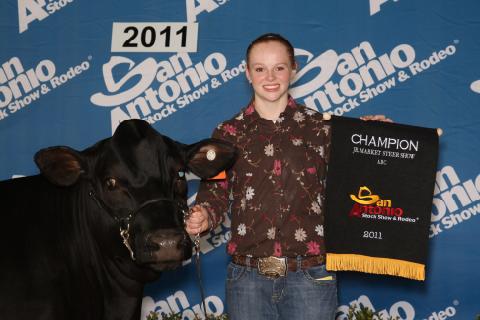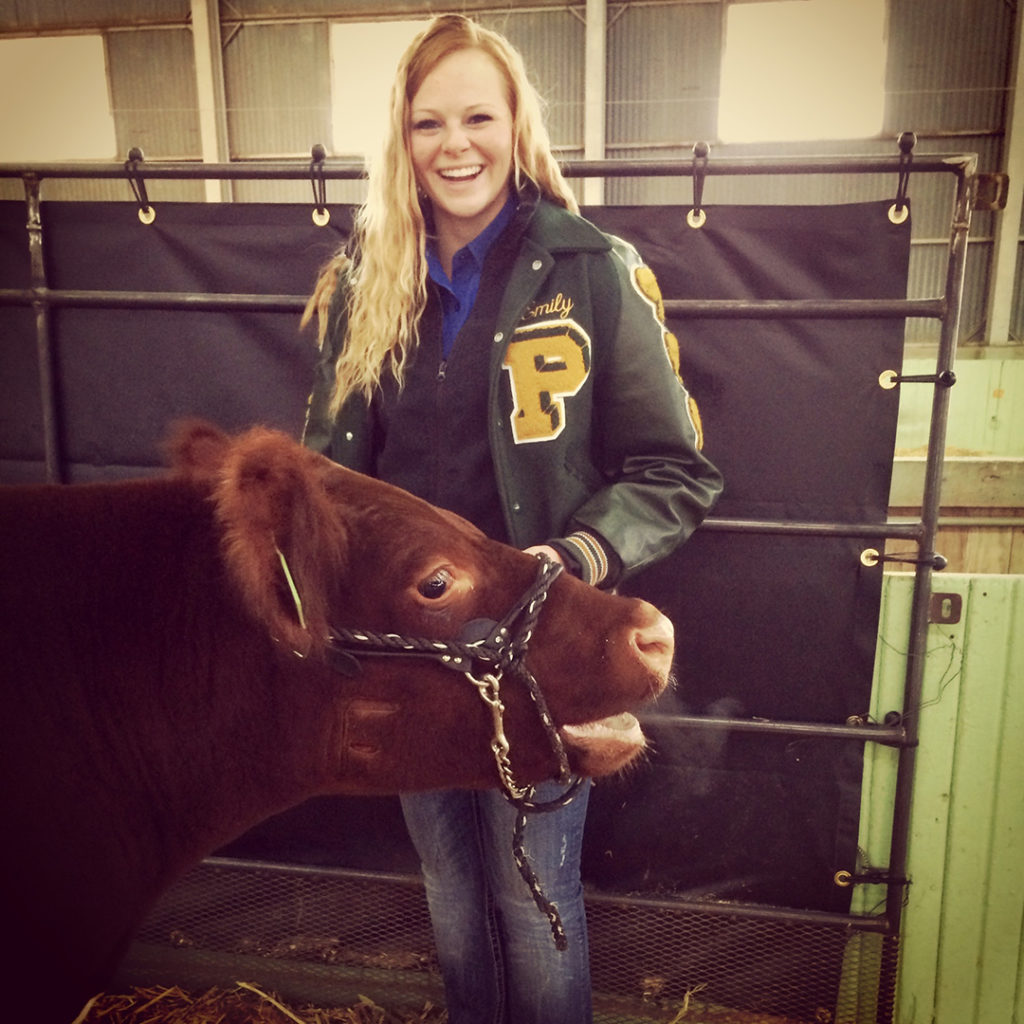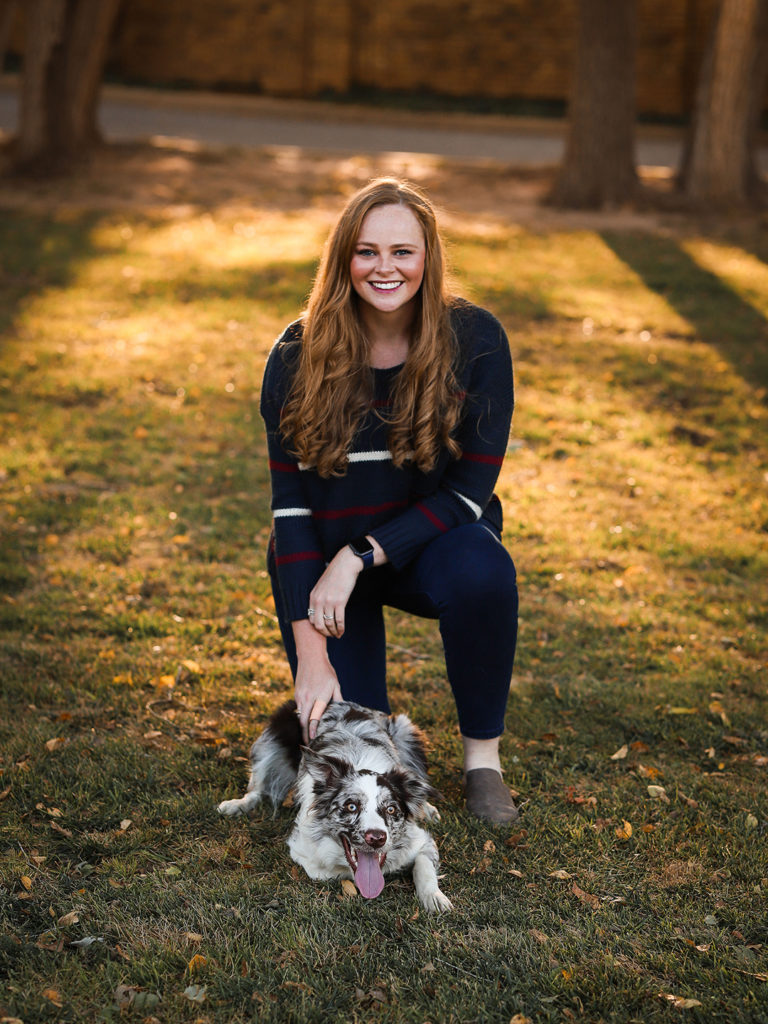Getting Back To Her Roots: Texas A&M Veterinary Student Begins Career As Rural Veterinarian
Story by Megan Myers, CVMBS Communications

Having grown up on her family’s beef cattle ranch in the small town of Pampa, Texas, fourth-year veterinary student Emily Terry is no stranger to working with livestock.
Her lifelong interest in cattle, combined with her desire to return to the Texas Panhandle, has led to her new job at the Animal Clinic of Perryton, located only 60 miles north of her hometown and seven miles south of the Texas-Oklahoma border.
As she graduates magna cum laude today from the Texas A&M College of Veterinary Medicine & Biomedical Sciences (CVMBS), Terry looks forward to serving ranchers like her family as a rural large animal veterinarian.
Growing Up In Rural Texas
When she was 9 years old, Terry decided to follow in the footsteps of her older cousins by raising pigs for junior FFA. Only two years later, she moved up to showing steers.
She continued working with animals throughout middle and high school, eventually showing through FFA, while also participating in FFA’s career and leadership development events.
“I always kind of knew that I wanted to become a veterinarian, but FFA definitely added to it,” Terry said. “It was a nice introduction to veterinary medicine. It was a little more knowledge than I already had, especially the parasites and the instruments that they didn’t ever really take the time to teach you when you’re working at a clinic.”
As a high schooler, she also began spending time each summer working at friend’s mixed-animal veterinary practice in Hillsboro.
“We saw food animals and a few horses, but it was definitely primarily small animal,” she said. “They’re not super close to many specialty practices and their clientele often didn’t have the funds to drive their animals to one, which gave the clinic some pretty advanced opportunities for rural medicine.”
After finishing high school, Terry moved to College Station to pursue a bachelor’s degree in animal science at Texas A&M, during which time she connected with Dr. Chris Skaggs, the College of Agriculture and Life Sciences’ associate dean for student development.

“Dr. Skaggs was really good about getting me involved during my animal science degree,” Terry said. “I proctored for some of the general animal science labs, and I helped with some of the judging contests and workshops.”
As it turned out, her connection with Skaggs ended up providing more than just volunteer opportunities—his brother, Dr. Randy Skaggs, is the owner of the Animal Clinic of Perryton, Terry’s new workplace.
“The Skaggses have been very influential my entire life, between Chris down here and now working for his brother,” she said. “It’s been really cool, seeing how that relationship carried through.”
Practical Experiences At VERO
Terry’s early interest in livestock led her to study veterinary medicine at the CVMBS, where she knew she could gain practical large animal experience during veterinary school.
Specifically, the CVMBS’ Veterinary Education, Research, & Outreach (VERO) campus in Canyon presented the perfect opportunity to get hands-on experience with cattle in a location not far from where she hoped to work as a veterinarian.
During her fourth year as a veterinary student, Terry completed three clinical rotations at VERO—in rural practice, dairy medicine, and cow/calf medicine—the first of which took place only two weeks into her clinical year.
“Those were some of my favorite rotations,” she said. “For the rural practice rotation, we divided our time between Dr. Joe Hillhouse (of Carson County Veterinary Clinic) in Panhandle and Dr. Zach Smith (of Dimmitt Veterinary Clinic) in Dimmitt. Both of them were really good about just stepping back and letting us do everything and then helping if we needed it.”
One of her favorite memories from her clinical year was when she had the chance to perform four cattle C-sections within 24 hours at VERO, an opportunity she most likely would not have had in College Station but was a realistic view of life as a rural veterinarian.
“One of my classmates and I had one of the most unique experiences in Dimmitt during our on-call shift over Memorial Day,” she said. “This guy came in on Friday with one cow that was having trouble giving birth, so we ended up doing a C-section during the day on Friday.

“Then, after we did that one, he said he had seven or eight others that he had also induced and he would probably be back with more. He called me right before I was getting ready to leave the next day saying he had another C-section coming in 30 minutes,” she said. “Five hours later, we had done three other C-sections and pulled one calf.”
Several months later, Terry returned to Canyon for her back-to-back dairy and cow/calf rotations, during which she spent a lot of time doing pregnancy check palpations.
The VERO rotations were doubly beneficial to Terry because of her strong interest in theriogenology, the science of reproduction.
“It’s just always been very interesting to me, the things that you can do to change the pregnancy and the ways you can get animals pregnant,” she said. “If you want all your cattle to get pregnant at the same time, you can make that happen. I’m excited to get to treat a lot more cattle in the future and have a bit of downtime to get certified for artificial insemination.”
At the clinic in Perryton, Terry will largely be seeing production beef cattle, which will provide many opportunities to perform pregnancy checks and her other favorite responsibilities. She’s also expecting to see plenty of small animals, plus the pigs, sheep, and goats that students in the local FFA chapter raise.
Terry said she is excited to soon be joining the ranks of rural veterinarians protecting our nation’s food supply, as well as returning “home” to the small-town life she knows and loves.
###
For more information about the Texas A&M College of Veterinary Medicine & Biomedical Sciences, please visit our website at vetmed.tamu.edu or join us on Facebook, Instagram, and Twitter.
Contact Information: Jennifer Gauntt, Director of VMBS Communications, Texas A&M College of Veterinary Medicine & Biomedical Sciences, jgauntt@cvm.tamu.edu, 979-862-4216


